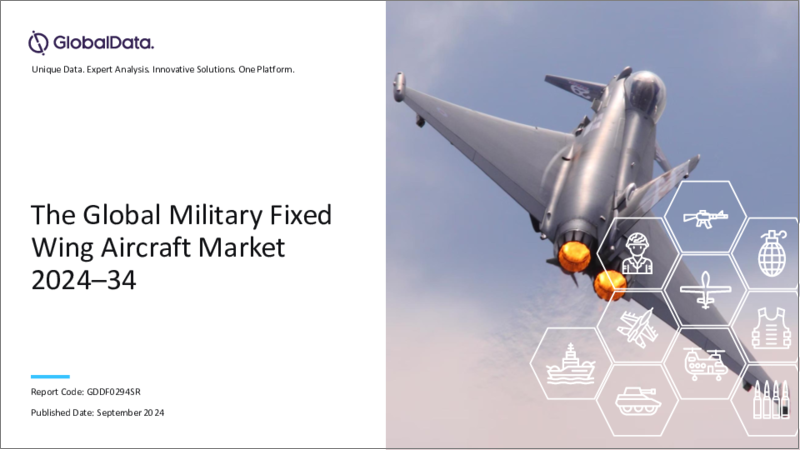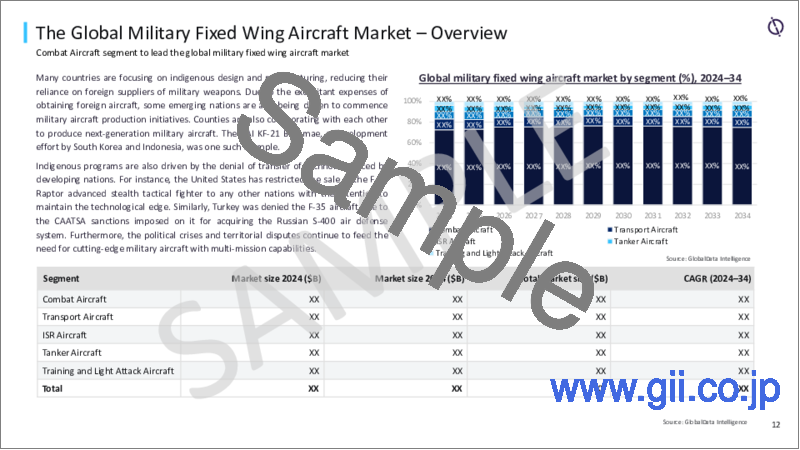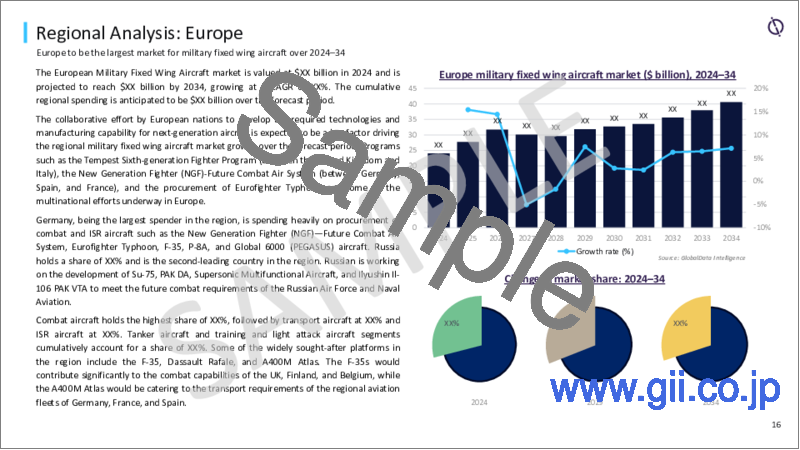|
|
市場調査レポート
商品コード
1590595
世界の軍用固定翼機市場:規模、動向分析:セグメント、主要プログラム、競合情勢と予測(2024年~2034年)The Global Military Fixed Wing Aircraft Market Size and Trend Analysis including Segments, Key Programs, Competitive Landscape and Forecast, 2024-2034 (Report & Dataset) |
||||||
カスタマイズ可能
適宜更新あり
|
|||||||
| 世界の軍用固定翼機市場:規模、動向分析:セグメント、主要プログラム、競合情勢と予測(2024年~2034年) |
|
出版日: 2024年09月16日
発行: GlobalData
ページ情報: 英文 60 Pages
納期: 即納可能
|
- 全表示
- 概要
- 目次
世界の軍用固定翼機の市場規模は、予測期間中に5.0%のCAGRで拡大すると見込まれています。同市場は、戦闘機、輸送機、ISR(情報・監視・偵察)機、タンカー機、訓練機、軽攻撃機の5つのカテゴリーに分類されます。予測期間中、欧州が29.6%の市場シェアで世界の軍用固定翼機市場を独占し、北米、アジア太平洋がこれに続くと予想されます。戦闘機は、予測期間中、軍用固定翼機のカテゴリーの中で最大のセグメントになると予想されます。
今後10年間で、軍用固定翼機市場は、第5世代の戦闘機に対する需要の増加により、急激な変化を遂げると予測されています。各国はすでに近代化に着手しており、老朽化した艦隊を最新の性能の航空機に置き換えて2050年代まで存続させる計画を立てています。中期的なアップグレードは、機体の寿命を最大10年延長することに重点を置いています。多くの国は、軍用兵器の海外サプライヤーへの依存を減らし、自国での設計と製造に注力しています。外国の航空機を入手するには法外な費用がかかるため、新興の軍事大国の中には、軍用機の国産化に力を入れている国もあります。調達プログラムは、低観測技術や情報収集能力の分野における最近の動向を確実に取り入れると同時に、プラットフォームの耐用年数にわたる運用コストの低減と手頃な取得コストに重点を置いて考案されており、これも予測期間中の軍用固定翼航空機の需要に影響を与えるとみられています。
戦闘機セグメントは最大セグメントであり、予測期間中、世界の軍用固定翼機市場の75.3%を占めると予想されます。戦闘機セグメントは、高度なセンサー、電子戦、通信、兵器システムを搭載した次世代マルチロール戦闘機の調達が伸びていることから、予測期間中に旺盛な投資を受けると予想されます。いくつかの国はすでに、戦闘の有効性を維持し能力を強化するために、老朽化した第3世代および第4世代の航空機を第4.5世代および第5世代の戦闘機に置き換えるプログラムを開始しています。
欧州地域は、2024年から2034年まで世界の軍用固定翼機市場を独占すると予想されます。ロシアとウクライナの戦争により、この地域のいくつかの国は敵の脅威を抑止するために航空機在庫の近代化を余儀なくされています。加えて、次世代航空機に必要な技術と製造能力を開発するための欧州諸国による協力的な取り組みが、予測期間にわたってこの地域の軍用固定翼機市場の成長を促進する主な要因になると予想されます。
当レポートでは、世界の軍用固定翼機市場について調査し、セグメント別、地域別の動向、技術開発、今後の予測などを提供しています。
目次
- エグゼクティブサマリー
- 世界の軍用固定翼航空機市場:概要
- 市場力学
- 需要の促進要因
- 動向
- 技術開発
- 主な課題
- 世界の軍用固定翼航空機市場:セグメント分析
- セグメント分析:戦闘機
- セグメント分析:輸送機
- セグメント分析:ISR航空機
- セグメント分析:タンカー航空機
- セグメント分析:訓練機と軽攻撃機
- 世界の軍用固定翼航空機市場- 地域分析
- 世界の軍用固定翼航空機- 地域概要
- 地域分析:欧州
- サプライヤーシェア分析
- 地域の主要国
- 地域別販売量シェア
- 地域分析:北米
- 地域分析:アジア太平洋
- 地域分析:中東
- 地域分析:アフリカ
- 地域分析:ラテンアメリカ
- 競合情勢と主要プログラム
- 主要市場参入企業
- 主なプログラム
The Global Military Fixed Wing Aircraft Market Size and Trend Analysis including Segments (Combat Aircraft, ISR Aircraft, Training & Light Attack Aircraft, Transport Aircraft, and Tanker Aircraft), Key Programs, Competitive Landscape and Forecast, 2024-2034 (Report & Dataset)
The Global Military Fixed Wing Aircraft Market 2024-2034 report provides a detailed forecast, including market size, CAGR, and regional breakdowns. It enables users to identify key segments and programs driving market growth, offering insights into future opportunities and investment areas. The report also assists OEMs and manufacturers in targeting high-potential markets, facilitating strategic planning and R&D investments to capitalize on emerging growth opportunities.
"The Global Military Fixed Wing Aircraft Market 2024-2034 report provides the market size forecast and the estimated compound annual growth rate (CAGR) for the next ten years. The report covers industry analysis, including the key market drivers, trends, emerging technologies, and major challenges faced by industry participants. It also offers insights regarding key factors and government programs that are expected to influence the demand for the military fixed wing aircraft market over the forecast period.
The quantitative dataset allows the user to find further insight into the market by giving the ability to dig deeper into the Equipment/Program designations in each country, the sub-segmental breakup, whether programs are indicative or aspirational, supplier information, and contract status. The level of data opens up a deeper understanding of the market that provides insight where the qualitative report ends.
Over the decade, the military fixed wing aircraft market is bound to witness radical change due to increasing demand for fifth-generation combat aircraft. Countries have already initiated their modernization drives, with plans laid down to replace aging fleets with the latest capabilities for relevance well into the 2050s. Mid-cycle upgrades have been focusing on extending the life of the fleet by up to a decade. Many countries are focusing on indigenous design and manufacturing, reducing their reliance on foreign suppliers of military weapons. Due to the exorbitant expenses of obtaining foreign aircraft, some emerging military powers are also focusing on indigenous military aircraft production initiatives. Procurement programs are being devised with emphasis on a lower operational cost over the life of the platform and an affordable acquisition cost, while also ensuring incorporation of recent developments in avenues of low observable technology and intelligence collection capabilities, which will also influence the demand for military fixed wing aircraft over the forecast period.
The combat aircraft segment is expected to be the largest segment and account for 75.3% of the global military fixed wing aircraft market over the forecast period. The combat aircraft segment is expected to receive robust investment over the forecast period, owing to the growth in procurement of next-generation multi-role combat aircraft with advanced sensors, electronic warfare, communication, and weapon systems. Several countries have already initiated programs to replace their aging 3rd and 4th generation aircraft with 4.5 and 5th generation combat aircraft to maintain combat effectiveness and enhance capability. According to Harshavardhan Dabbiru, Defense Analyst at GlobalData, "many countries are focusing on indigenous design and manufacturing of combat aircraft, reducing their reliance on foreign suppliers. Due to the exorbitant expenses of obtaining foreign aircraft, some emerging nations are also being driven to commence military aircraft production initiatives, which is expected to reduce costs and increase procurement volumes, thereby resulting in the growth of the segment."
The Europe region is expected to dominate the global military fixed wing aircraft market from 2024 to 2034. The Russia-Ukraine war has forced several countries in the region to modernize their aircraft inventory to deter adversary threats. In addition, the collaborative efforts by European nations to develop the required technologies and manufacturing capability for next-generation aircraft is expected to be a key factor driving the regional military fixed wing aircraft market growth over the forecast period. Programs such as the Tempest Sixth-generation Fighter Program (between the United Kingdom and Italy), the New Generation Fighter (NGF)-Future Combat Air System (between Germany, Spain, and France), and the procurement of Eurofighter Typhoon are some of the multinational efforts underway in Europe."
Key Highlights
- The global military fixed wing aircraft market is expected to grow at a CAGR of 5.0% over the forecast period.
- The global military fixed wing aircraft market is classified into five categories: combat aircraft, transport aircraft, ISR (intelligence, surveillance, and reconnaissance) aircraft, tanker aircraft, training and light attack aircraft.
- Europe is expected to dominate the global military fixed wing aircraft market over the forecast period with a market share of 29.6%, followed by North America and Asia-Pacific regions.
- Combat aircraft is expected to be the largest segment among the military fixed wing aircraft categories over the forecast period.
Scope
In particular, the report provides an in-depth analysis of the following -
- Market size and drivers: Detailed analysis during 2024-2034, including the demand drivers and growth stimulators. It also provides a snapshot of the spending and modernization patterns of different regions around the world.
- Recent developments and industry challenges: Insights into technological developments and a detailed analysis of the existing military fixed wing aircraft being executed and planned worldwide. It also provides trends of the changing industry structure and the challenges faced by industry participants.
- Regional highlights: study of the key markets in each region, providing an analysis of the key segments of the market that are expected to be in demand.
- Major programs: details of the key programs in each segment, which are expected to be executed during 2024-2034.
- Competitive landscape and strategic insights: analysis of the competitive landscape of the global military fixed wing aircraft market. It provides an overview of key players, their strategic initiatives, and financial analysis.
The dataset provides additional quantitative insight into each segment, user, country and supplier and allows the customer to understand the metrics that underpin each point raised in the report.
Reasons to Buy
- Access quantitative and qualitative data and insight into the global military fixed wing aircraft market over the next ten years.
- Determine prospective investment areas based on a detailed trend analysis of the market
- Gain in-depth understanding about the underlying factors driving demand for different military fixed wing aircraft market segments in the top spending countries across the world and identify the opportunities offered by each of them
- Strengthen your understanding of the market in terms of demand drivers, industry trends, and the latest technological developments, among others
- Identify the major channels that are driving the global military fixed wing aircraft market, providing a clear picture about future opportunities that can be tapped, resulting in revenue expansion
- Channelize resources by focusing on the ongoing programs that are being undertaken by the defense ministries of different countries within the global military fixed wing aircraft market
- Make correct business decisions based on in-depth analysis of the competitive landscape consisting of detailed profiles of the top military fixed wing aircraft solution providers around the world. The company profiles also includes information about the key products, alliances, recent contract awarded, and financial analysis, wherever available
Table of Contents
Table of Contents
- Executive Summary
- Global Military Fixed Wing Aircraft Market: Overview
- Market Dynamics
- Demand Drivers
- Trends
- Technological Developments
- Key Challenges
- Global Military Fixed Wing Aircraft Market: Segment Analysis
- Segment Analysis: Combat Aircraft
- Segment Analysis: Transport Aircraft
- Segment Analysis: ISR Aircraft
- Segment Analysis: Tanker Aircraft
- Segment Analysis: Training & Light Attack Aircraft
- Global Military Fixed Wing Aircraft Market - Regional Analysis
- Global Military Fixed Wing Aircraft - Regional Overview
- Regional Analysis: Europe
- Supplier share analysis
- Leading countries in the region
- Regional volume share
- Regional Analysis: North America
- Supplier share analysis
- Leading countries in the region
- Regional volume share
- Regional Analysis: Asia-Pacific
- Supplier share analysis
- Leading countries in the region
- Regional volume share
- Regional Analysis: Middle East
- Supplier share analysis
- Leading countries in the region
- Regional volume share
- Regional Analysis: Africa
- Supplier share analysis
- Leading countries in the region
- Regional volume share
- Regional Analysis: Latin America
- Supplier share analysis
- Leading countries in the region
- Regional volume share
- Competitive Landscape and Key Programs
- Leading Market Players
- Key Programs






